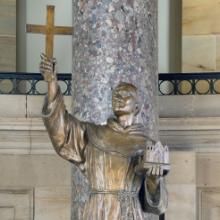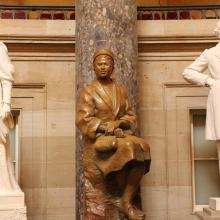U.S. Capitol
In the immediate aftermath of Jan. 6, 2021, I naively believed that the violent attempt to overturn the 2020 election outcome would serve as a breaking point for the nation and the Republican Party. Despite the party’s anti-democratic slide, including so many embracing the lie that the 2020 election was stolen, I thought the collective horror of the day — felt across the political spectrum — would awaken everyone to the danger that former President Donald Trump and his enablers posed to our democracy. Of course, we now know that isn't what happened.
Less than a week into the new year, the country watched in shock as hundreds of rioters used metal pipes and tear gas against police to gain entry into the U.S. Capitol, ransacking congressional offices for several hours while the nation’s elected leaders, who had convened to certify electoral votes, huddled for cover. But faith-based communities and other justice advocates saw something like this coming.
As pro-Trump rioters broke into the Capitol on Wednesday to stop members of Congress from certifying the results of the 2020 election, some evangelical leaders denounced the violence — including elected representatives who continued to support President Donald Trump’s debunked claim that the election was “stolen.”
At a news conference on May 15, in front of the United Methodist Building, leaders of congregations and denominations called on fellow African Americans to speak up, and urged Congress to vote down proposed plans by the new administration that they believe help the rich and hurt the sick and the poor.
With ashes on their foreheads, sackcloth draped around their necks, and the U.S. Capitol as a backdrop, Christians leaders used the words “evil” and “immoral” to describe the federal budget cuts President Trump has proposed and many Republican lawmakers favor.
“It is a time for lamentation,” said the Rev. David Beckmann, explaining the symbols of grief the clergy brought to Capitol Hill on March 29.

Image via James Lawler Duggan / REUTERS / RNS
Facing throngs of people on the National Mall, Nation of Islam Minister Louis Farrakhan called for justice Oct. 10 as he rallied African-Americans, Latinos, and others during an anniversary protest at the U.S. Capitol.
In a speech that lasted more than two hours, Farrakhan said the United States was hypocritical for insisting other nations were violating human rights, all the while describing its own misconduct as something that causes Americans “dissatisfaction.”
His “Justice or Else!” event came 20 years after hundreds of thousands of black men came to the same stretch of lawn between the Capitol and the Washington Monument to rededicate themselves to being better fathers, sons, and citizens.
Junipero Serra, the 18th-century Franciscan missionary who’s set to be declared a saint later this year despite protests from Native American groups, could lose his place of honor in the U.S. Capitol if a California lawmaker has his way.
State Sen. Ricardo Lara, an openly gay Los Angeles Democrat, wants to replace a bronze statue of Serra with a monument honoring the late Sally Ride, the nation’s first female astronaut. Lara said Ride would become “the first member of the LGBT community” to be honored in Statuary Hall.
Each state is allowed two statues to represent local heroes; California’s other statue is of former President Ronald Reagan, who joined the collection in 2009, replacing a monument to itinerant preacher Thomas Starr King. The King and Serra statues were added in 1931.
“Dr. Sally Ride is a California native, American hero and stratospheric trailblazer who devoted her life to pushing the limits of space and inspiring young girls to succeed in math and science careers,” Lara said in a statement.
“She is the embodiment of the American dream.”
THE METRO IS crowded today, and the 20-something, well-dressed white man has to stand, one hand holding the bar and the other his smartphone. It’s the end of the day. All the commuters—but one—are turned toward home. The young man’s face, like most of the others, is dulled with exhaustion. No one makes eye contact.
In a seat near the door, one woman sits facing everyone, looking backward. She studies the young man’s face intently, uncomfortably. He shifts. She rearranges the bags at her feet. Her reflection in the window shows an ashy neck above her oversized T-shirt collar. The train hums and clicks through a tunnel. As if in preparation, she takes another sip from the beat-up plastic cup she’s holding.
At last, she raises her voice and asks: “Why are white people so mean?” Boom! The electricity of America’s third rail crackles through the train. Faces fold in like origami or turn blank like a screensaver.
But this was no rhetorical question. When no one answers, she asks again, this time aiming her question at the young man with his phone. A flush creeps up his neck. “You look like you could be a sheriff,” she says to him. “Good and mean. I can see it in your eyes. You got mean eyes.” When he realizes her attention is stuck on him, he replies, “I hope I’m not mean. I try to be good.”
Thousands of people flooded the National Mall on Wednesday to call on Congress for commonsense immigration reform that includes a roadmap to earned citizenship for the estimated 11 million undocumented immigrants living in the United States.
Coupled with a day of lobbying on Capitol Hill and sibling rallies across the country, Wednesday’s was one of the biggest immigration rallies to date. Sponsored by the Service Employee International Union, Casa de Maryland, the NAACP, and more, the rally began with an interfaith prayer service and featured the voices of faith leaders, including UMC Bishop of Los Angeles Minerva Carcaño, Director of Religious Action Center for Reform Judaism Rabbi David Saperstein, Director Hispanic Diocese of Arlington Padre Jose Eugenio Hoyos, and Islamic Center of Maryland Imam Jamil Dasti.
WASHINGTON — A bronze statue of civil rights heroine Rosa Parks was unveiled at the U.S. Capitol Wednesday, a day for members of her African Methodist Episcopal Church to celebrate one of their own.
President Barack Obama, capping an hourlong ceremony in Statuary Hall, recalled the desegregation of public buses in Montgomery, Ala., after a yearlong boycott that was sparked by Parks’ simple act of defiance: refusing to move to the back of the bus.
“And with that victory, the entire edifice of segregation, like the ancient walls of Jericho, began to slowly come tumbling down,” he said before hundreds gathered just outside the Capitol Rotunda.
As Parks was hailed for her civil rights achievements, members and leaders of her African Methodist Episcopal Church celebrated Parks taking her place among the monuments to American icons from every state and walk of life.
Parks was a stewardess, who helped with Communion and baptisms in her local AME congregation in Detroit, and also a deaconess, the highest position for a laywoman in the denomination. She died in 2005 at age 92.







